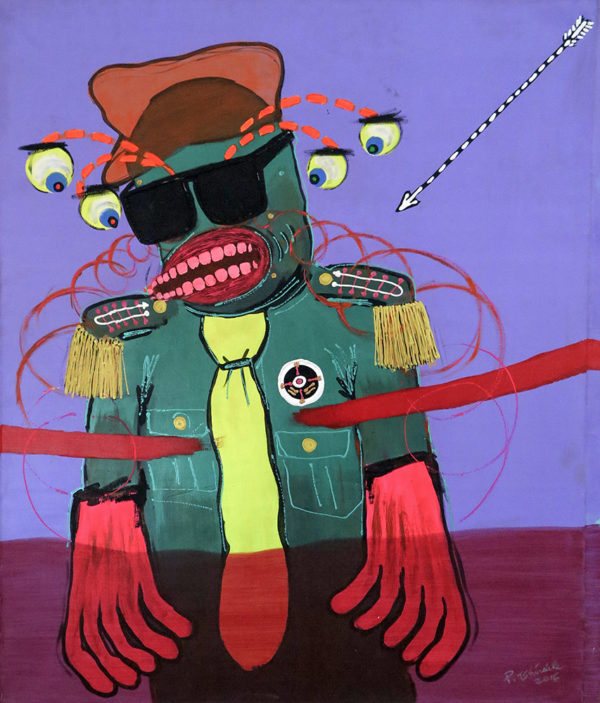Alignés/Non-alignés
Pathy Tshindele (Democratic Republic of Congo)
2019
Alignés/Non-alignés is part of a reflection that Pathy Tshindele leads to the long course on power and its various avatars. Every few five years, a period that corresponds to the renewal of the world’s political elites, he created a new series of paintings featuring the new faces of power. Alignés/Non-alignés is made from an old photograph of a traditional Kuba chief in traditional costume. The mediocre grain of the cliché does not capture the details of the costume that Tshindele reinterprets in his own way. The fact that the photo is of poor quality is a deliberate choice of the artist, who believes that the vagueness of clothing details echoes the one secreted by the power. In the face of the chief Kuba are however substituted those of Trump, Macron and Merkel in particular. A substitution that sounds like an invitation to question power; who actually holds the latter, the heads of state or the economic system? These new faces that appear chronically in the news are they synonymous with real transformations or on the contrary, the immutability of a system where only change the head while the balance of power that maintain it, remain unchanged? Whatever the answer, the vertical of power remains intact; the bottom of the pyramid illustrated by the Kuba costume, undergoes the decisions of the “thinking heads”.
Born in 1976 in Kinshasa, Pathy Tshindele studied sculpture at the Académie des Beaux-Arts of Kinshasa. From 2005 to 2008 he studies at the Ecole Supérieure des Arts Décoratifs of Strasbourg. He is one of the founding members of the artist collective Eza Possible, created in 2003 at the Academy of Fine Arts of Kinshasa around six artists: Pathy Tshindele, Méga Mingiedi, Eddy Ekete, Kura Shomali, Kennedy Dinanga and Freddy Mutombo. They came up with the idea of using what is roaming in the streets, what people don’t want anymore, stories, carcasses, scrap metal, leftovers from everyday life to transform them into installations and put them in the middle of the academy.
Interested in the proximity with his native city, Tshindele tries to put aside what he learned at school to learn more from the streets, the daily life, the atmosphere and warmth of the city of Kinshasa. His work can be situated between contemporary art and the ‘peintres populaires’ that he saw since he was a child. He develops performances in the urban space, his own personal street art. Connecting art to life, Pathy Tshindele wants to question the world and let the violence and the urgency make a mark on his work. It is his way of letting his country enter his art, a country as vast as its wealth, to cross culture and politics. His paintings capture the intertwining of his personal history, the people and the world to which he belongs.


